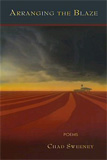December 5, 2009ARRANGING THE BLAZE
Review by James Benton
Anhinga Press
P.O. Box 10595
Tallahassee, FL 32302
ISBN 978-1-934695-09-8
2009, 106 pp., $15.00
www.anhinga.org
Genealogy arises from the urge to uncover one’s origins. In Chad Sweeney’s hands, the search for origins permeates a stirring collection of angular poems that are simultaneously personal and deceptively private. His book, Arranging the Blaze, examines in fine detail not merely the question of biological origins, but also the sources of his insecurities, his personal values, even his poetic muse. These poems exhibit craft and sensitivity as they explore a wide range of human conditions, using multilayered language that invites the reader to spend extra time unpacking each poem’s message.
The poem “Genealogy,” for example, a sort of Americanized version of Seamus Heaney’s “Digging,” offers an early look at the subtlety of Sweeney’s piercing observations. Tracing the source of the speaker’s sense of revelry and repression, the poet explains:
Mother before she was my mother,
Sheryl hung
by her knees from the redbud treeallowing the white Sunday
dress to flow over her head
allowingher hair scented with lye and faith
to comb patterns in the dust,
recording the day upside down:The smart white house of Mary’s father,
who emerged in his Sabbath black to cast
a look of such contemptand hurry his daughters into the car –No,
Sheryl can’t come to our church any more—
that the moment of first shamewould evoke itself
in a thousand carpeted hours.
It is in me.
Other poems in this series deal with sources too, but each one from a far different perspective than the others. “History,” opens with the amazing image, “It happened slowly / the way cliffs raise the bones of whales,” before invoking such dissimilar elements as a Buick, the Northern Lights, bears, bison, and raccoons. “The Welders” again reveals Sweeney’s attention to telling detail and his skill at bridging a metaphor’s tenor and vehicle:
I’ve seen their work before
wherever theory
or boneneeded binding,
would otherwise lay back
in its own vein of oreiron
among the malachite,
Irish among their dead,
The more closely one reads these poems, the clearer it becomes that there is not a word out of place in any of them.
In the section titled, “Arc of Intention,” the poems are more autobiographical, conjuring memories of “Grandpa Sweeney,” his parents, his wife, and some thoughts on the wasteland of the California desert. He closes the section with a long meditation on the occasion of meeting his future in-laws. The risk with autobiographical poems is triviality (who really cares about some stranger’s personal demons?), but Sweeney deftly avoids this in each case by showing us the familiar through an unfamiliar lens. The effect is to provoke the empathy that comes through self-recognition while adding to our experience by offering alternative viewpoints. As personal as it might be, one can’t resist being transported by the moral urgency of “The Mile,” a poem that only seems to be about a car crash. This poem fully supports its dramatic core and earns every ounce of its emotional power:
…
There is so much to talk about
at this moment,so many lines of cause and effect
trembling taut into that gully.
How does my father choose—with his mother’s ribs broken,
his new wife moaning from the ditch—
to carry the limp bodyof someone else’s child
a mile over night fields
toward the insinuation of a roof?
But Sweeney does not wallow in the morose. He creates an equally strong emotion in “Climax,” a poem that should be read as erotica to gain its fullest effect: “when you are ready // you will release the oars / and stand / into the arc of the fall.”
Perhaps the best reason to add this volume to one’s permanent collection is the section titled “Basho’s Robes.” Here, Sweeny offers thirty-three alternative translations of a single Basho Haiku. Anne Carson suggests in “The Secret Life of Towns” that how one perceives an object depends upon where one stands in relation to it. Shift one’s position, and the object looks vastly different to the observer even though the object itself remains unaltered. “My pear, your winter,” Carson says. Sweeney takes this idea and runs straight at Basho with it, producing thirty-three unique poems from a single template.
Rather than seek to transliterate toward a definitive version in English, Sweeney exploits the inherent limitations of language to reveal the depth of the original Haiku as well as the incredible range of this spare form. It is an extraordinary exercise. The poet’s fidelity is to the sense of the poem, not its formal structure, thus the opening iteration, which we take to be the “original,” reads:
Ancient pond;
the frog jumps in—
splash!
Subsequent iterations vary as to the number of syllables per line, and even the number of lines, but the intent is to burrow to the center of Basho’s meaning, and the result is a startling sequence of insightful variations on the theme. The following examples suggest something of the bold yet nuanced interpretations contained in this sequence:
desire
occluded by the dream—
one feather dipped in bloody = mx + b
x2 + y2 = 169
Ø
By the time the reader reaches iteration number 33, the return to the beginning is as sweetly satisfying as an extended Beethoven cadence:
the frog has escaped
to lay her eggs
in the rain gutter
The poems in Sweeney’s wonderful collection do not readily disclose their secrets. While the diction is unpretentious, the imagery ranges outside the ordinary, the metaphors stretch the imagination, and the poem’s occasions sometimes misdirect the reader’s attention. All of this makes for a rich body of work that draws the reader back like an explorer to the source of a nourishing river, or a perhaps like a son tracing his genealogy.
____________